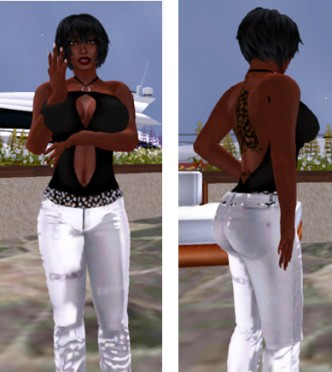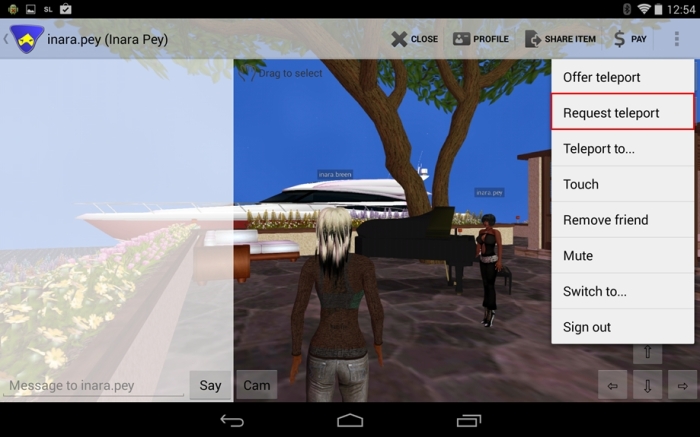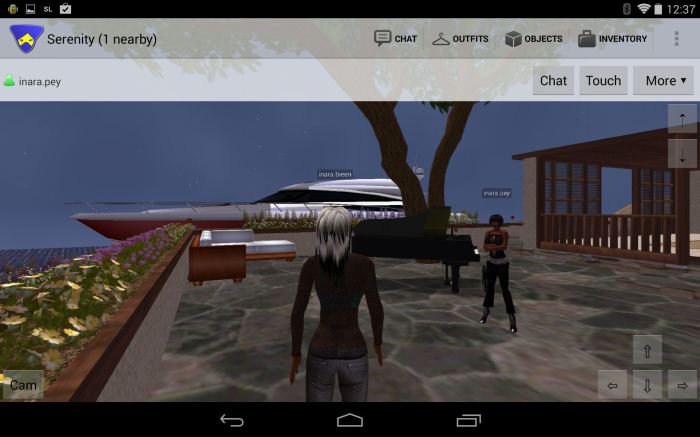 Update May 13th: Lumiya 2.6.1 is now available. This includes a fix to prevent the client crashing when rendering megaprims, improved mesh download speeds and reduced lage when walking.
Update May 13th: Lumiya 2.6.1 is now available. This includes a fix to prevent the client crashing when rendering megaprims, improved mesh download speeds and reduced lage when walking.
Alina Lyvette announced the arrival of the latest release of Lumiya on Friday May 9th.
Version 2.6.0 marks the arrival of support for Fitted Mesh and some pretty impressive under-the-hood changes which greatly enhance Lumiya’s performance in the areas of memory use, bandwidth utilisation and 3D rendering – and I found the improvements really are noticeable.
Feature Updates
Fitted Mesh Rendering
The Fitted Mesh support is perhaps the most visible update in terms of new features. I only carried out a quick series of tests, but found the FM demos I had from back when testing the SL Fitted Mesh viewer (I’m ashamed to say I’ve still not actually started using any mesh clothing myself…) worked just fine when rendered by Lumiya.

I did experience slight issues with mesh clothing failing to render when worn, something I don’t remember occurring back when mesh support was first released. Should this happen, a quick fix seems to be hopping out of the 3D view and back again.
Request Teleport
Another feature update with this release is the Request Teleport option. This can be accessed by:
- Selecting the person you wish to teleport to from your Friends list, or IM
- Tapping the MORE option
- Tapping Request Teleport. This opens the Request Teleport message screen where you can enter your request text (or leave blank, if you prefer). Tapping OK will close the message window and send the teleport request
- If the request is accepted, you will receive a teleport offer, as per usual; if the request is declined, you will not receive any feedback (which is how Request Teleport is handled in the viewer and not a result of Lumiya failing to receive a notification).

Avatar Interaction
Lumiya 2.6.0 makes it easier to interact with nearby avatars when in 3D view by applying a long touch to the centre of an avatar. This may take a little practice, but when used, will call-up a menu allowing you to initiate an IM session with that avatar, examine them, etc.

If you have problems using the long touch method when selecting an avatar, don’t forget you can also use the Drag To Select option in the top left corner of the 3D view and drag that down to point to the avatar in question.
Under-the-Hood
The under-the-hood changes in 2.6.0 range from fixes for known crash issues through to better support for transparency in the 3D world view and new notification sounds (courtesy of Lhasa Mencur) to some really quite significant performance improvements.
The latter include a reduced memory footprint together with much improved bandwidth usage, both of which see Lumiya operate a lot more smoothly (not that it was ever particularly clunky). Much has been done to the 3D rendering performance and management as well.Also these combined mean it should be much easier to run Lumiya on lower-end system, and for those on high-end devices, to have more of the bells and whistles turned on. In my case, for example, these improvements make it a lot easier to run with High Quality Textures enabled by default on my Nexus 2013 HD.
Feedback
Lumiya has always offered tremendous value for accessing Second Life while on-the-go with a suitable Android device. Even allowing for trying to maintain compatibility with older versions of Android, Alina consistently pulls-off some impressive miracles with the client, and 2.6.0 more than demonstrates this. While the added features may seem minimal (even though mesh support represents considerable work itself), the performance improvements evident in this release are astonishing.
Obviously, with a fairly high-end Android device running Android KitKat and a quad-core Qualcomm Snapdragon™ S4 Pro, 1.5 GHz / Adreno 320, 400 MHz combination, I stand to benefit the most from the improvements in rendering, but even so, on my old Samsung Galaxy S2 with Android 4.1 Jellybean and Dual-core 1.2 GHz Cortex-A9 / Mali-400 combination, things were still noticeably faster.
For those who require access to OpenSim and are Android users with a decent CPU / GPU combination and a reason screen size, Lumiya stands head-and-shoulder above the rest. For those wanting mobile access to Second Life and have limited screen size, it also beats SL Go hands-down in terms of convenience of use, even if it lacks the full rendering capabilities of the latter.
Related Links
- Lumiya home page
- Download – Google Play
- Download – Android Pit (accepts payments via PayPal)
- Lumiya in this blog
Another advantage Lumiya offers is that its camera offsets are more than acceptable and greatly facilitate in-world navigation. With SL Go, whose camera offsets are much worse than those of the official viewer, I always have to remember to wear Penny Patton’s camera control HUD (which I’ve also modified to bring closer to my personal settings).
LikeLike
I’m glad they are “fune tuning” :))
LikeLike
That’s what comes of trying to deal with RL and sort-out four different blog posts. All because my minions have decided to take the weekend off …
LikeLike
I bought Lumiya pretty much minutes after it originally came out. Alina is a freaking miracle worker with this app. Each time you think “Wow, this can’t get any better!”…she proves you wrong! And for the small, one time fee?! Insane value! WE LOVE YOU ALINA, thank you for all of your efforts!
LikeLike
Can this be run on a Desktop or Laptop? If I had the skill I would try to make a “Camera Only” and features viewer for Machinima. I imagine that could be lean and mean. Are there tutorials for making clients or tweaking them?
LikeLike
Well, theoretically you could, but Lumiya is built for Android and handles graphics very differently. As such, you’d be better off having a regaular viewer tweaked for your specific requirements. Plus several of the TPVs out there already bring together the tools and debug settings within the viewer specifically for machinima makers.
LikeLike
the more i use lumiya on my nexus 7 2013, the more i am surprised and shocked at the features and how well it performs in comparison to the client on my laptop and my desktop. since it has all these features and such great performance, you’d think that LL or FS could learn a thing or two about performance and optimization, considering all the lack of hardware performance my tablet has in comparison to the other devices, keep up the great work! and thank you for the push update to 2.6.2
LikeLike
What makes it even more amazing is that, to the best of my understanding, Alina does all of this by herself. As for Firestorm, it is tied to the official viewer’s source code – for better or worse.
LikeLike